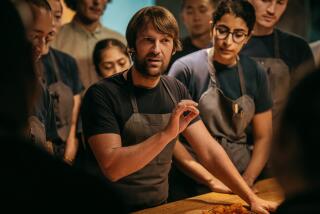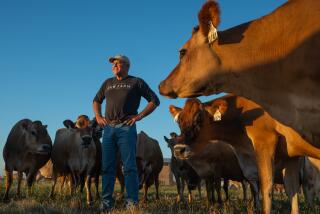Are rotten tomatoes the future?
Today’s question: Is the scare over salmonella-tainted tomatoes a sign of a real problem, or just something we should expect to happen every now and then? All week, Paul Roberts and Jacob Grier debate the new food economy.
Fast, cheap and contaminated
Point: Paul Roberts
Unfortunately, the tomato scare is both the sign of a real problem and something we should expect to happen again and again -- because little that regulators are proposing will fix what’s broken. The problem here isn’t simply weak laws or too few inspectors (although tougher regulations and substantially more inspectors would help). Rather, the problem is a production system that has become dangerously overstretched trying to satisfy demand by retailers (and consumers) for ever-lower prices and nonstop, year-round availability.
Make no mistake: our food system is dramatically safer than the one our grandparents had. You’re still far more likely to die driving to the grocery store than from anything you buy there. That said, in the last decade, we’ve seen a shift in produce outbreaks -- in terms of the number of outbreaks, the kinds of pathogens and the pattern of attacks -- that is strikingly parallel to changes in the ways we grow and ship produce.
For example, to meet the growing appetite for spinach and salad greens, growers in the 1980s dramatically expanded farm acreage and developed large-scale processing facilities. They came up with innovative packaging materials, and a highly efficient refrigerated “cold chain” that could get salads, spinach and other products from field to grocery display case in 48 hours or less. Then, because retailers recognized the massive profit potential in year-round availability (the longer a particular fruit or vegetable is kept in stock, the more of it consumers will buy), they pushed the industry to create a supply chain that follows the growing season as it moves across the country -- or the planet.
The good news? Produce is now so cheap and easy to get that per-capita consumption is up -- a huge plus for our otherwise sorry national diet. The downside is the system is now more vulnerable to attack by pathogens like salmonella and E. coli. For example, in expanding production in the Salinas Valley, some growers pushed farms into areas traditionally used for cattle ranching -- with the likely result that E. coli was able to move from the cow patch to the vegetable patch. Similarly, the same large-scale packing and washing sheds that have driven down processing costs may also be making it easier for pathogens like salmonella and E. coli to spread from one contaminated leaf to many others. Lastly, the high-speed distribution system means a pathogen, once it enters the food supply, can be broadcast quickly -- often faster than it can be tracked.
Health officials still don’t know the origin of the salmonella-tainted tomatoes that eventually wound up in nearly two dozen states.
Growers and distributors, under rising pressures from regulators and retailers, are scrambling to improve their systems to avoid future outbreaks. Many retailers, for example, refuse to buy produce from farm fields that aren’t fenced against wildlife (which can carry pathogens) or which are prone to flooding (both salmonella and E. coli can be carried in ground and surface water.) But if we really want to curb this threat, everyone in the food chain -- growers, retailers and consumers -- may need to realize that in the case of food, there is such a thing as too cheap and too fast.
Paul Roberts writes about the economics and politics of food, energy, and other key “inputs.” His most recent book, “The End of Food,” has just been published by Houghton Mifflin.
Don’t panic
Counterpoint: Jacob Grier
The scare over salmonella-tainted tomatoes and other recent outbreaks of food-borne diseases are real problems. Paul, as you note here and in your book, the growth of large-scale farming and longer, more complex supply chains increases the risk that bacteria will work their way into the produce supply. The problem is analogous to the development of refrigerated rail cars, which made it possible to get fresh milk to cities, but also let pathogens from one cow spread throughout the pooled milk. The solution then was pasteurization. With produce, however, there is no “kill step.” Once bacteria make their way into our fresh vegetables, we’re somewhat stuck with them.
Yet although this is a concern, our food supply is still exceptionally safe. Our challenge is to take reasonable steps to protect consumers without making it difficult to enjoy fresh produce because of higher prices, decreased availability or exaggerated dangers. Food scares make for good headlines, but the reactions often exceed the risks. When the tiny risks of mad cow disease drove diners away from resource-intensive beef, there were at least some health benefits. We wouldn’t want to see the same reaction against spinach and tomatoes.
I agree that increased inspections could be a good first step, though it’s unclear how cost-effective they would be. According to the Government Accountability Office, inspecting the more than 250,000 domestic and foreign facilities just once per year would cost upward of $3 billion. It’s more encouraging to see the pressures that retailers themselves are placing on suppliers to protect their crops from potential exposure to pathogens. Growing interest in seasonal, regionally grown foods is also a good sign, though this will likely remain a small share of the market.
Food scares inevitably lead to calls for greater regulation, opening the door to influence by special interests with their own agendas. These could take the form of protectionist trade restrictions that raise prices for consumers. Other safety measures may be tailored in favor of the dominant agricultural system. In the meat industry, for example, the USDA’s proposed National Animal Identification System would use expensive electronic monitoring equipment to track individual animals or, alternatively, entire lots of animals that move through the production chain as a group. The capital costs and lot option favor big players, and smaller farmers are rightly concerned that additional safety concerns will lead to the program’s becoming mandatory. The high capital and compliance costs of these systems would harm the smaller, regional farmers you and I would like to see provide more of our food.
Despite the flaws in our ultra-convenient food system, problems will have to get much worse for consumers to give up the real benefits of year-round availability, rapid delivery and a diversity of fruits from all over the world. And if the problem escalates, they will make that choice. For now, we should experiment with better safety and sourcing, and not allow food scares to undermine our enjoyment of bountiful produce.
Jacob Grier is a bartender and think tank PR manager. He writes about food and regulation at www.jacobgrier.com.
Day 1 | | | |
More to Read
A cure for the common opinion
Get thought-provoking perspectives with our weekly newsletter.
You may occasionally receive promotional content from the Los Angeles Times.










